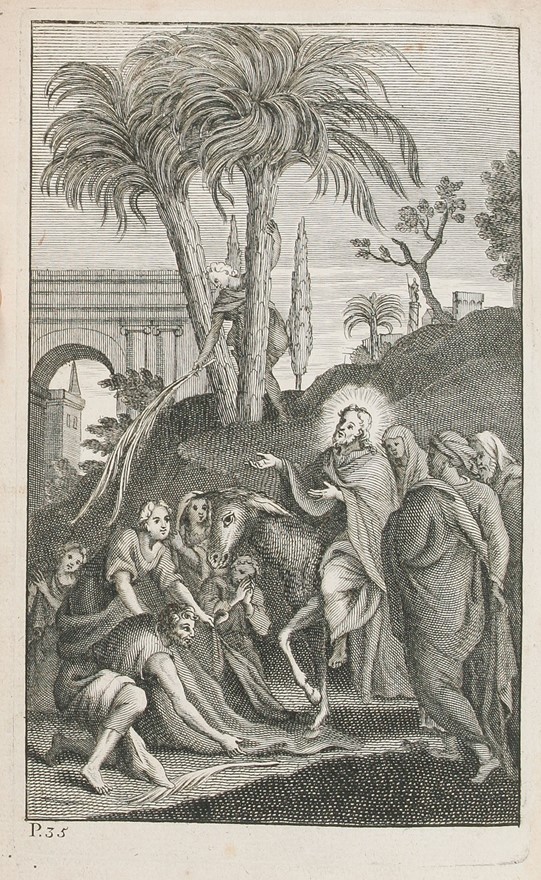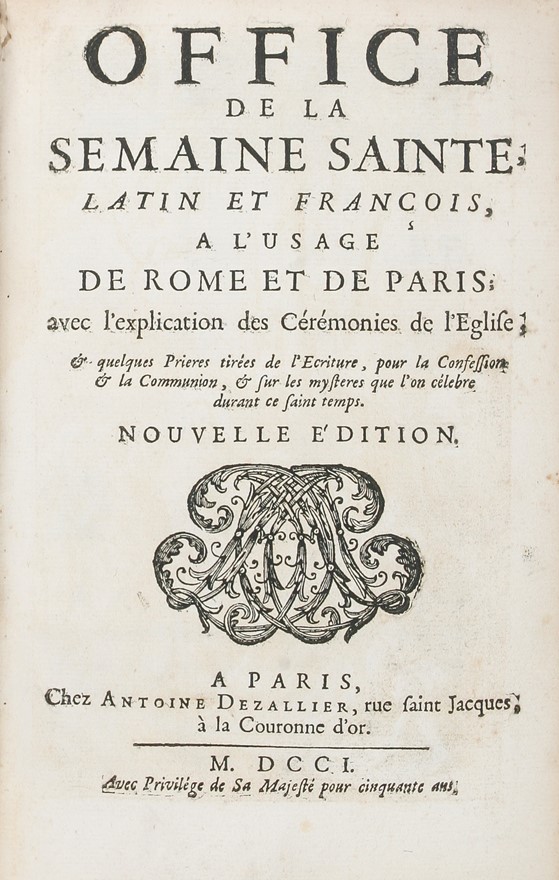Office de la Semaine Sainte, Latin et François, a l'usage de Rome et de Paris avec l'explication des Cérémonies de l'Eglise... nouvelle édition. Paris, Antoine Dezallier, 1701
HOLY WEEK, Latin and French (1701)
£2000.00
Please contact us in advance if you would like to view this book at our Curzon Street shop.
Engraved frontispiece of Christ's entry into Jerusalem, engraved plates of the Last Supper, the Crucifixion and the Resurrection.
8vo (205 x 130mm). [3]ff. xxxii, 653pp. [1]f. Contemporary French red morocco, triple gilt fillet on covers, corner rosettes, central arms of Elisabeth Charlotte of Bavaria, spine gilt in compartments with her repeated crowned monogram, marbled endpapers, i.e.g., g.e.
Beautifully bound in red morocco with the arms of Elisabeth Charlotte of Bavaria (1652-1722), second wife of the Duc d'Orleans, brother of Louis XVI of France, previously known as Princess Palatine. Olivier notes that she formed an important collection of medals, as well as a library of mostly theological works, including the works of Bossuet.
Elisabeth Charlotte, who left behind some 90,000 letters after her death, "remains, along with Saint-Simon, the best surviving source of information on life at Versailles ... Combining commentary on the mores of the royal court with descriptions of major events and lively anecdotes, these letters paint an intimate picture of life at the palace. As mother of the future regent, Princess Palatine’s letters refrain from criticising Louis XIV, whom she admired.
"Elizabeth-Charlotte of Bavaria, often referred to as “Liselotte” or “La Palatine”, was a German princess of Protestant upbringing. In 1671 she married Monsieur, the King’s brother, and was obliged to convert to Catholicism. She took up residence in the Court and became an astute observer of goings-on at the palace. An avid letter-writer, her correspondence covers the great events of the day as well as the more mundane aspects of life at court. From her desk in the Palais-Royal, the Château de Saint-Cloud or the Palace of Versailles, she brought her famously sharp nib to bear on the main characters in the continual drama that was life in the court. Her letters, closely scrutinised by Superintendent of Post M. de Torcy, spread a less than flattering image of the royal court throughout Europe. Between 1674 and 1676, despite her husband’s acknowledged preference for male company, she gave birth to three children. One, Philippe II, Duke of Orléans, would serve as regent for Louis XV. Her correspondence in French and German, of which only a tiny part survives, is widely considered to be among the best contemporary accounts of the Grand Siècle. She died at Saint-Cloud in December 1722." (Château de Versailles website).
Olivier 2564 (fer 6 & 11).
Stock Code: 224714






